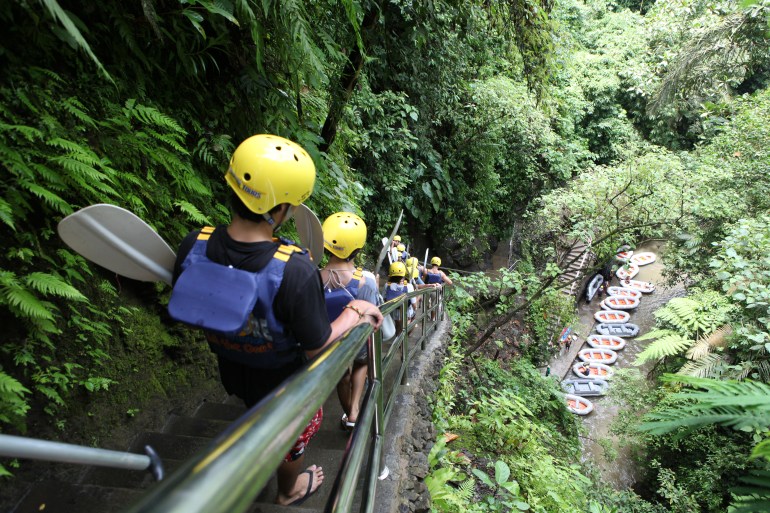Bali, Indonesia – On October 3 last year, 64-year-old United States citizen Robinaugh Clifford Neil and nine other foreign tourists set off on two inflatable rafts for a white-water rafting trip down the Ayung River, the longest and holiest river in Bali.
The first half of the trip progressed smoothly. But when the group stopped for a break at a riverside kiosk, the river rose dramatically. A female vendor advised the two rafting guides to abort the trip but the advice was ignored, according to a member of the search party that followed.
Within moments, both rafts flipped over and all 12 people fell into the rapids.
Eventually, the guides and eight out of nine tourists made their way to the river bank, emerging with only minor scrapes and bruises. But Neil never returned. His body was last seen going over a weir without a helmet or lifejacket but was never recovered, despite a weeklong search effort.
Neil is not the only tourist to have lost his life while white-water rafting in Bali.
In November, a tourist from Saudi Arabia was thrown from a raft, hit her head against a rock and drowned while rafting in the Telaga River in east Bali.
In November 2021, three Indonesian tourists, including two children who had just completed a rafting trip on the Ayung River, perished after rain triggered a landslide on a steep jungle path between the river and the road.
Repeated warnings
In the view of some experts familiar with Bali’s rafting scene, all five deaths, instead of simply being tragic accidents caused by unpredictable weather events, can be traced to the government’s failure to regulate the industry as well as a culture of lax safety standards.
Nigel Mason, who pioneered white-water rafting in Bali in the 1980s, said he made repeated failed attempts to convince local officials to introduce the kind of standard operating procedures that exist in Australia and other developed nations over fear that lives would be lost otherwise.
“The American tourist died on what we call a ‘red-river’ day,” Mason, who runs Mason Adventure Rafting, told Al Jazeera.
“We have three classifications for the river. The first is green. When the river gets to yellow, we ban anyone over 50 and children from rafting and warn everyone else about the challenge involved. Once it turns red from too much rain in the mountains, we cancel our trips. The water in the river can rise six metres in an hour; it’s extremely dangerous inside there. But some companies just keep going because they don’t want to lose money.”

Cok Ace, the deputy governor of Bali who previously owned a share in a white-water rafting company Sobek, substantiated some of Mason’s comments.
“I used to take my family quite often but not in the rainy season,” Ace told Al Jazeera, referring to the period that usually stretches from November to April.
“Because if the Ayung River is flooded, it’s dangerous.”
The fact that Neil’s body was seen floating in the river without a lifejacket or helmet suggests his safety equipment was faulty or not properly fitted by his guides, Mason said, pointing out poorly-constructed access trails to the river as another safety risk.
“If you go on our tour, you’ll notice we have concrete staircases complete with handrails leading hundreds of metres down to the river. But some of these new companies just cut steps into the soil or lay concrete blocks that can slide away,” he said. “That’s exactly what happened when the three tourists died in a landslide last year.”
Mason said the root cause of all these problems is lax government oversight.
“There are no standard operating procedures specific to rafting like the safety equipment rafts need to carry, the age and condition of lifejackets, working hours for guides, alcohol consumption, the number of rafts allowed on the river at any one time and rescue protocols. All investors need to do is apply for a ‘location’ permit to access the river and that’s good enough to start conducting rafting trips,” he said.
“There are guides on the river who don’t even know how to swim.”

After the death of the Saudi tourist last year, police in east Bali ordered rafting companies to improve their risk-assessment protocols before heading into the water.
“I reminded the rafting operators to increase their vigilance because it’s the rainy season [and] the water discharge has increased. There was a flood and the rafting route should have changed,” local police chief I Gede Made Punia told reporters at the time.
No charges were brought against BMW Rafting, the company that organised the Saudi woman’s trip. Made Agus Kertiana, the company’s owner, told local media the woman’s death was an unavoidable tragedy.
“Disasters and destiny cannot be avoided and we are very saddened by the tragedy that happened yesterday,” Kertiana told Bali Factual News, adding that a 250 million rupee ($16,624) payout made by his insurer was evidence of his responsible management.
Authorities did not bring charges against Ayung Dewata Rafting, the company that organised Neil’s trip. A person who answered a number listed for the company hung up the phone when contacted by Al Jazeera.
Of 14 locally-owned rafting companies and travel agents that sell rafting tours contacted by Al Jazeera, only one agreed to discuss safety in the industry.
Founded in 2016, Arum Jeram Bali takes 100 to 150 tourists rafting on the Ayung River each day. The only injuries their customers ever have suffered are small wounds caused by tourists who did not follow the instructions of their guides, according to the company’s owner Putu, who like many Indonesians goes by only one name.
Putu said that he cancels trips when the river appears “dangerous” because of rain and has built quality concrete staircases leading from the road to the river with handrails when required.
“I think rafting on the Ayung River is quite safe,” he told Al Jazeera.
‘Terrified’
Travellers’ experiences of rafting tours recounted online paint a picture of questionable safety standards across the industry.
On Tripadvisor, dozens of reviews detail negative experiences, including having to navigate staircases to the water with large, slippery and unpaved steps – conditions Al Jazeera observed at two different paths used by rafting companies to access the Ayung River.
In one review on the site, an Australian commenter going by Neen Starmine describes capsizing during a rafting tour in 2017 due to poor directions from her guide.
“He said go right, which should have been left and flipped the boat. My daughter, myself and another teenage girl were trapped under the raft taking water into our lungs. At that stage, I could not find my daughter and was terrified,” she wrote.
“Luckily we got ourselves out and after being swept downstream a bit, dragged ourselves ashore. After a few minutes and a lot of coughing, we were back in the boat. I was so shocked that they would raft in the river with such danger. If I had known, I never would have gone”.
Ibu Pande, secretary at the Gianyar Tourist Office that administers tourism in the Ayung River area, said standard operating procedures (SOP) specific to rafting are part of the licensing process for white-water rafting.
“There are SOP for rafting companies because it’s quite risky,” Pande told Al Jazeera, adding that her office checks “some” of the rafting companies to ensure the SOP are being followed. When asked, Pande declined to name any specific SOPs or produce any document detailing them.

According to Mason, on the day Neil died, Ayung Dewata Rafting, the company that organised his tour, took other tourists out on the river while the search for the American’s body was still under way.
“We don’t have the authority to stop the operation of the company,” Pande said, adding that no review or changes to the SOP were implemented in the wake of the fatal accident. “It’s safe as long as tourists follow the instructions of their guide. But we can’t predict what nature will do,” she said.
An officer at the Gianyar Police Station who led the investigation into the accident said on condition of anonymity that charges have not been laid against Ayung Dewata Rafting’s owners or guides because police are still treating it as a missing person case
“The body hasn’t been found so we don’t know if the tourist died, but he is still missing,” the police officer told Al Jazeera.
Mason, whose staff led the search for Neil until it was abandoned, said there is no doubt that Neil died in the river and warned that more tourists could lose their lives if Bali’s white-water rafting scene is not subject to better regulation.
“There will always be rafting accidents, that’s the nature of the game,” he said. “But if the authorities want to make the industry safe, they need to introduce and enforce SOP. Unless they do that, it can only lead to new disasters.”
The author of this article requested their name be withheld due to fears of retaliation by the Indonesian government.
Sumber: www.aljazeera.com
 Skip to content
Skip to content

